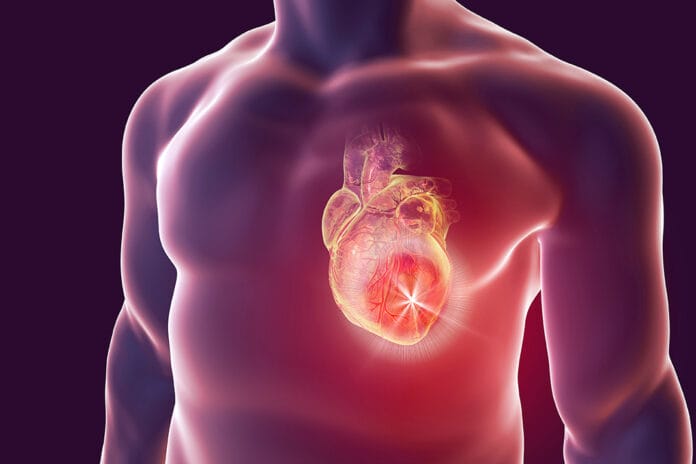Heart disease is on the rise, and it is no secret that it’s the leading cause of death in men and women across all racial aspects in the United States. Sadly, every 34 seconds, someone dies of cardiovascular disease.1 Due to the commonality of this disease, dental hygienists will frequently see patients afflicted with heart disease in our dental chairs.
Heart disease should be taken seriously, and certain precautions for the safety of the patient should be taken during dental treatment. Heart disease is a large umbrella that encompasses various types of heart-related illnesses.
Heart disease includes, but is not limited to:1
- Congenital heart disease
- Rhythm disorders
- Valvular disease
- Peripheral artery disease
Cardiovascular Disease Risk Factors
Some risk factors for cardiovascular disease are inherent, and there is little that can be done to change them. This includes age, gender, and family history of heart disease. However, modifiable risk factors, or risk factors you can change, should be the focus of healthcare providers when discussing heart disease and goals to improve overall health and quality of life.2
Modifiable risk factors for heart disease include:2
- High blood pressure
- High blood cholesterol
- Smoking/tobacco use
- Obesity
- Physical inactivity
- Diabetes
- Unhealthy diet
Smoking is a leading risk factor. Nicotine in tobacco causes an increase in heart rate and blood pressure.3 In 2021, nearly 28.3 million Americans 18 or older smoked.4
According to the American Heart Association’s most recent annual report, high blood pressure affects 122.4 million Americans 20 years or older.1
Another risk factor is obesity. The most recent annual report shows that 71.2% of Americans 20 years or older are overweight or obese.1 Obesity is attributed to diet and inactivity, which are also risk factors for heart disease, making this combination a triple threat.
Diabetes increases the risk of developing cardiovascular disease twofold. Additionally, diabetes and periodontal disease have a bidirectional relationship, which puts dental hygienists in a position to help patients manage their diabetes through improved oral health, thus possibly reducing their risk of developing cardiovascular disease.5
Cardiovascular Disease Premedication
Dental professionals are not strangers to circumstances that require particular cardiac patients to premedicate with antibiotic prophylaxis. However, the American Heart Association continues to modify the requirements, and many dental professionals are conflicted about which patients should be premedicated.6
Currently, the American Heart Association recommends antibiotic prophylaxis to help prevent infective endocarditis (IE) for the following cases:6
- Prosthetic cardiac valves, including transcatheter-implanted prostheses and homografts
- Prosthetic material used for heart valve repairs, such as annuloplasty rings, chords, or clips
- Previous IE
- Unrepaired cyanotic congenital heart defect (birth defects with oxygen levels lower than normal) or repaired congenital heart defect with residual shunts or valvular regurgitation adjacent to the site of a prosthetic patch or prosthetic device
- Cardiac transplant with valve regurgitation due to a structurally abnormal valve
If it is determined that prophylactic antibiotics are necessary, it is most appropriate that the cardiologist provide the prescription and instructions for use. This information should be documented in the patient’s clinical chart. The American Dental Association and American Heart Association guidelines state, “If the dosage of antibiotic is inadvertently not administered before the procedure, the dosage may be administered up to 2 hours after the procedure.”7
Local Anesthetic
Patients that are well-managed with medication are generally not at an increased risk of cardiac events with a local anesthetic. Conversely, vasoconstrictors are contraindicated in patients with untreated, unregulated, or unstable angina. Caution should be taken when administering vasoconstrictors to patients with pacemakers, especially implanted automated defibrillators.8
It should be noted that patients with ischemic heart disease are more vulnerable to the negative effects of endogenous catecholamines, which include adrenaline that is released by the body’s adrenal gland, as a result of severe pain during dental treatment than they are to a small amount of epinephrine in local anesthetics. Endogenous adrenaline is naturally highest from 8 am to 11 am, so appointing the patient later in the day is a simple modification that could reduce the risk of a cardiac event in the dental office.8
If a local anesthetic cardiac dose is indicated, the recommended dosage of epinephrine for patients with cardiovascular disease should not exceed 0.04 mg. This is the equivalent of two 1.8 cc cartridges of anesthesia with a dilution of 1:100,000 of epinephrine.8
Periodontal Pathogens Linked to Cardiovascular Disease
Particular oral bacteria have a positive association with heart disease. A recent study of 3,459 individuals discovered that 6% of the participants had suffered a heart attack or other serious cardiovascular event within the 12-month follow-up period.9
The researchers tested each individual for bacteria, viruses, and parasites. They discovered that F. nucleatum, an oral bacterium, might contribute to cardiovascular risk through increased systemic inflammation due to bacterial presence in the mouth or through direct colonization of the arterial walls or plaque lining the arterial walls.9
P. gingivalis, T. denticola, and T. forsythia are all gram-negative anaerobic oral bacteria found in periodontal disease that have a common association with cardiovascular disease.8 Individuals with periodontitis are reported to have an increased risk of developing heart disease, contributing to coronary artery disease, stroke, myocardial infarction, and atherosclerosis. P. gingivalis was found in 100% of patients of the carotid endarterectomy species examined in one study, and two or more species of periodontal-associated bacteria were detected in 64% of atherosclerotic plaque of cardiac patients with periodontal disease.10
Patients with cardiovascular disease need dental treatment just as much as anyone, if not more, considering the risk of oral bacteria’s positive association with heart disease. When reviewing health history, it can be helpful to specifically ask about cardiac health and document any findings the patient shares.
In addition, reviewing current medications and identifying what the patient takes the medication for can help tease out information the patient may not be aware is relevant. Unfortunately, some patients are not well versed in their medical diagnosis, and identifying medications associated with cardiovascular disease may prompt the need for dental professionals to consult with the patient’s primary care physician or cardiologist to identify their specific condition. Medical conditions should always be documented in the patient’s clinical chart.
Dental Treatment after Myocardial Infarction
Dental treatment is considered low cardiac risk. The risk of death or myocardial infarction within 30 days of a dental procedure is less than 1%.6 However, those who have suffered a recent myocardial infarction are at a high risk of reoccurring cardiovascular events and will need special considerations when scheduling dental care. Over 70% of relapses occur in the first month after the initial incident.8
After myocardial infarction, the healing process lasts over six weeks, allowing a post-infarction scar to form. At one point, the American Heart Association guidelines extended the period during which avoiding dental procedures was recommended to six months.8 However, due to the advances in cardiac management, the six-month waiting period is no longer recommended, and dental professionals should follow the six-week post-infarction time frame.8
While not every myocardial infarction patient will fall into this recommendation, it would be best for the dental professional to contact the patient’s cardiologist for guidance and clearance.
When in doubt, always consult with the patient’s cardiologist as they know the mutual patient’s cardiac health better than we do. Postpone any appointments when clearance cannot be obtained prior to treatment.
In Closing
When treating patients, obtaining a detailed, updated medical history at every appointment is important. Identifying risk factors and obtaining blood pressure readings will assist the dental professional in treating patients with cardiovascular disease. When risks are identified, dental hygienists can take this opportunity to educate the patient. Educating patients who are at risk will strengthen the link of oral health to overall health, as well as help patients understand why necessary precautions are needed. Establishing this connection may be the turning point in some patients’ oral health diligence.
Just as patients do not always understand their diagnosis, many do not understand the oral-systemic link associated with periodontal disease and multiple systemic diseases. When asked about changes in their medical history, this is often evident in the infamous response, “Nothing to do with my mouth.” Hearing this response is a perfect opportunity to discuss the oral-systemic link and the importance of dental professionals having a complete medical history.
In addition, helping patients to understand the oral-systemic link through proper education will further corroborate the dental hygienists’ professionalism and role as preventive oral care specialists and help keep patients with cardiovascular disease safe during dental treatment.
Before you leave, check out the Today’s RDH self-study CE courses. All courses are peer-reviewed and non-sponsored to focus solely on pure education. Click here now.
Listen to the Today’s RDH Dental Hygiene Podcast Below:
References
- Tsao, C.W., Aday, A.W., Almarzooq, Z.I., et al. Heart Disease and Stroke Statistics – 2023 Update: A Report from the American Heart Association. Circulation. 2023; 147(8): e93-e621. https://doi.org/10.1161/cir.0000000000001123
- Heart Disease Facts. (2023, May 15). Centers for Disease Control and Prevention. https://www.cdc.gov/heartdisease/facts.htm
- American Heart Association Editorial Staff. (2022, December 6). Understand Your Risks to Prevent a Heart Attack. American Heart Association. https://www.heart.org/en/health-topics/heart-attack/understand-your-risks-to-prevent-a-heart-attack
- Current Cigarette Smoking Among Adults in the United States. (2023, May 4). Centers for Disease Control and Prevention. https://www.cdc.gov/tobacco/data_statistics/fact_sheets/adult_data/cig_smoking/index.htm
- Heart Disease and Stroke. (2022, September 8). Centers for Disease Control and Prevention. https://www.cdc.gov/chronicdisease/resources/publications/factsheets/heart-disease-stroke.htm
- American Heart Association Editorial Staff. (2021, March 4). Infective Endocarditis. American Heart Association. https://www.heart.org/en/health-topics/infective-endocarditis
- Antibiotic Prophylaxis Prior to Dental Procedures. (2022, January 5). American Dental Association. https://www.ada.org/en/resources/research/science-and-research-institute/oral-health-topics/antibiotic-prophylaxis
- Samulak-Zielińska, R., Dembowska, E., Lizakowski, P. Dental Treatment of Post-myocardial Infarction Patients: A Review of the Literature. Dent Med Probl. 2019; 56(3): 291-298. https://dmp.umw.edu.pl/pdf/2019/56/3/291.pdf
- Oral Bacteria may Increase Heart Disease Risk. (2023, February 14). eLife Sciences Publications Limited. https://elifesciences.org/for-the-press/d09b443c/oral-bacteria-may-increase-heart-disease-risk
- Leishman, S.J., Do, H.L., Ford, P.J. Cardiovascular Disease and the Role of Oral Bacteria. Journal of Oral Microbiology. 2010; 2(1). https://doi.org/10.3402/jom.v2i0.5781












